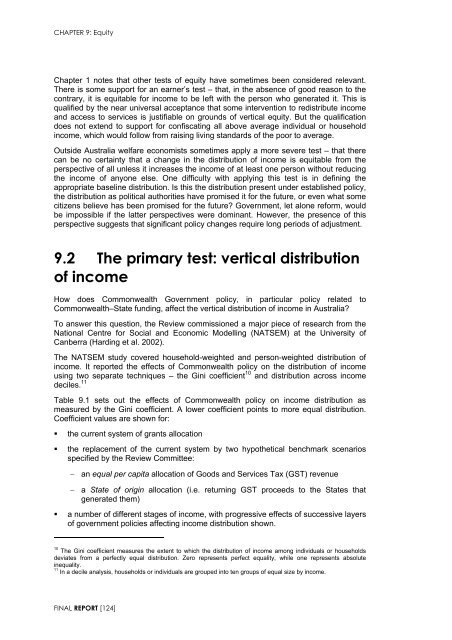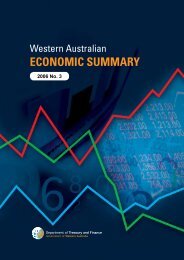Garnaut Fitzgerald Review of Commonwealth-State Funding
Garnaut Fitzgerald Review of Commonwealth-State Funding
Garnaut Fitzgerald Review of Commonwealth-State Funding
You also want an ePaper? Increase the reach of your titles
YUMPU automatically turns print PDFs into web optimized ePapers that Google loves.
CHAPTER 9: Equity<br />
Chapter 1 notes that other tests <strong>of</strong> equity have sometimes been considered relevant.<br />
There is some support for an earner’s test – that, in the absence <strong>of</strong> good reason to the<br />
contrary, it is equitable for income to be left with the person who generated it. This is<br />
qualified by the near universal acceptance that some intervention to redistribute income<br />
and access to services is justifiable on grounds <strong>of</strong> vertical equity. But the qualification<br />
does not extend to support for confiscating all above average individual or household<br />
income, which would follow from raising living standards <strong>of</strong> the poor to average.<br />
Outside Australia welfare economists sometimes apply a more severe test – that there<br />
can be no certainty that a change in the distribution <strong>of</strong> income is equitable from the<br />
perspective <strong>of</strong> all unless it increases the income <strong>of</strong> at least one person without reducing<br />
the income <strong>of</strong> anyone else. One difficulty with applying this test is in defining the<br />
appropriate baseline distribution. Is this the distribution present under established policy,<br />
the distribution as political authorities have promised it for the future, or even what some<br />
citizens believe has been promised for the future Government, let alone reform, would<br />
be impossible if the latter perspectives were dominant. However, the presence <strong>of</strong> this<br />
perspective suggests that significant policy changes require long periods <strong>of</strong> adjustment.<br />
9.2 The primary test: vertical distribution<br />
<strong>of</strong> income<br />
How does <strong>Commonwealth</strong> Government policy, in particular policy related to<br />
<strong>Commonwealth</strong>–<strong>State</strong> funding, affect the vertical distribution <strong>of</strong> income in Australia<br />
To answer this question, the <strong>Review</strong> commissioned a major piece <strong>of</strong> research from the<br />
National Centre for Social and Economic Modelling (NATSEM) at the University <strong>of</strong><br />
Canberra (Harding et al. 2002).<br />
The NATSEM study covered household-weighted and person-weighted distribution <strong>of</strong><br />
income. It reported the effects <strong>of</strong> <strong>Commonwealth</strong> policy on the distribution <strong>of</strong> income<br />
using two separate techniques – the Gini coefficient 10 and distribution across income<br />
deciles. 11<br />
Table 9.1 sets out the effects <strong>of</strong> <strong>Commonwealth</strong> policy on income distribution as<br />
measured by the Gini coefficient. A lower coefficient points to more equal distribution.<br />
Coefficient values are shown for:<br />
• the current system <strong>of</strong> grants allocation<br />
• the replacement <strong>of</strong> the current system by two hypothetical benchmark scenarios<br />
specified by the <strong>Review</strong> Committee:<br />
− an equal per capita allocation <strong>of</strong> Goods and Services Tax (GST) revenue<br />
− a <strong>State</strong> <strong>of</strong> origin allocation (i.e. returning GST proceeds to the <strong>State</strong>s that<br />
generated them)<br />
• a number <strong>of</strong> different stages <strong>of</strong> income, with progressive effects <strong>of</strong> successive layers<br />
<strong>of</strong> government policies affecting income distribution shown.<br />
10<br />
The Gini coefficient measures the extent to which the distribution <strong>of</strong> income among individuals or households<br />
deviates from a perfectly equal distribution. Zero represents perfect equality, while one represents absolute<br />
inequality.<br />
11<br />
In a decile analysis, households or individuals are grouped into ten groups <strong>of</strong> equal size by income.<br />
FINAL REPORT [124]

















